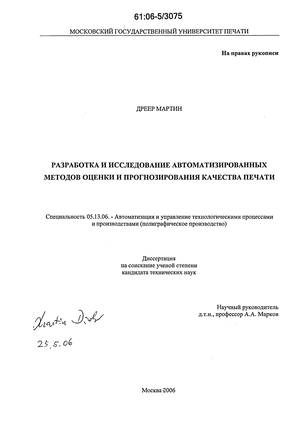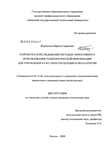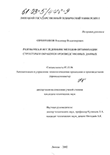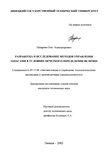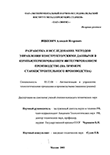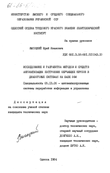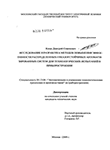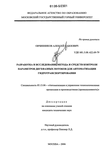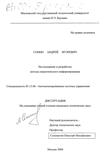Содержание к диссертации
Declaration 1
1. Preface 23
2. Terms and Abreviations 24
2.1. Common Terminology 24
2.1.1. Halftoning (Screening) 24
2.1.2. Screen Angles 24
2.1.3. (Halftone) Screen Ruling .24
2.1.4. Moire and Rosettes 25
2.1.5. Moire Period 26
2.1.6. Colour Drift. 26
2.1.7. Supercells 26
2.1.8. Resolution 26
2.1.9. Addressibility
2.1.10. Raster Image Processor-RIP. 28
2.1.11. Dot Join and Respective Characteristics 28
2.1.12. Halftone Definition Matrix, Threshold Limit Matrix, Halftone Dictionary 29
2.2. Utilized Abreviations 29
2.2.1. Raster Image Processor-RIP. 29
2.2.2. FFT: Fast Fourier Transformation 30
3. Introduction 31
3.1. What is a Halftone Screen? 31
3.2. Printing foto-realistic images 32
3.3. Problems Associated with Halftone 33
3.4. The Limits of this Dissertation
3.4.1. Concentration on Flexography with digitally imaged fotopolymer plates 36
3.4.2. Commercial Quality will not be Seeked 36
3.4.3. Halftone Screen Definitions only as Threshold Limit Matrices 36
3.4.4. No Hybrid Screens 37 Dissertation Martin Dreh
3.4.5. Rational Tangens Screen Angles only 37
3.5. Summary ,.38
4. Retrospective 39
4.1. The Historic Development of Halftoning 39
4.1.1. Conventional Halftone Screens 39
4.1.1.1. Colour Printing with Three Inks 39
4.1.1.2. Colour Printing with Four Inks
4.1.2. Stochastic (Frequency Modulated) Screens 42
4.1.3. Hybrid Screens 43
4.2. Strengths and Weaknesses 44
4.2.1. Conventional Halftone Screens 44
4.2.2. Stochastic (Frequency Modulated) Halftone Screens 45
4.2.3. Hybrid Screens
4.3. Formal Definition of the Goal of this Dissertation 47
4.4. Summary 48
5. Theoretical Part M
5.1. Currently available commercial halftone screening systems 51
5.1.1. Types of Screens 51
5.1.1.1. Resolution, Addressibility and Tonal Precision 51
5.1.1.2. Amplitude Modulated Halftone Screens 53
5.1.1.3. Stochastic (Frequency Modulated) Halftone Screens 57
5.1.1.4. Hybrid Screens 60
5.1.2. Known Strengths and Concerns with the Use in Flexo 61
5.1.2.1. Amplitude Modulated Screens 61
5.1.2.2. Frequency Modulated Screens 62
5.1.2.3. Hybrid Screens 63
5.2. Newly developed Screens for Flexo 64
5.2.1. Why new Screens for Flexo anyway?
5.2.2. Criteria for Suitability 64
5.2.3. Potential Shapes for Halftone Dots 65
5.3. Criteria for Evaluation of Halftone Screens Dissertation Martin Dreher
5.3.1. Dot Join Characteristics and Shadow Definition 67
5.3.2. Highlight Fade-out and Differentiation •„ 67
5.3.3. Angling Possibilities and Necessities 68
5.3.4. How the Flexo Printed Result Depends on the Chosen Halftone Screen Angles 69
5.3.5. Optical Recognizability and Definition 69
5.3.6 Potential for Seamless Screening 70
5.4. Mechanisms of Electronically Generating Halftone Dots 71
5.4.1. Look-up Tables 71
5.4.2. Halftone Dictionaries, Threshold Limit Matrices 72
5.4.3. Definition as Mathematical SPOT-Function (PostScript) 72
5.4.4. Definition as Grey Level File (Halftone Dictionary) 73
5.5. The Applied Method 75
5.5.1. Research About Potential Halftone Dot Shapes 75
5.5.2. Making the Threshold Limit Matrices (Halftone Dictionaries) 76
5.5.3. The Different Haluone Screen Rulings 77
5.5.4. Making the Halftone Screen Angles 78
5.5.5. Applying the Threshold Limit Matrices on the RIP. 78
5.6. Summary 80
6. Practical Part 83
6.1. The Utilized Tools, Instruments and Machines 83
6.1.1. CorelDraw... 83
6.1.2. Corel Photopaint , 84
6.1.3. Grapholas with Ghostscript-RIP (Interpreter) 84
6.1.4. Image Analysis Software Image] 84
6.1.5. UMAXPowerlook 2000 Scanner with MagicScan Software 85
6.1.6. Platesetter CDI Advance byEsko Graphics and Processing Equipment for Fotopolymer Flexo Printing Plates 85
6.1.7. Proof Printing Press Flexiproof100 byRK. 86
6.1.8. Central Impression Cylinder Flexo press "Meisterflex" by Lehmacher 87
6.2. The Making of the Self Developed Halftone Screens 88 Dissertation Martin Dreher
6.2.1. Trials for Construction of the Threshold Limit Matrices 88
6.2.2. The Selected Method -...90
6.2.3. Calculating the Setup Values for Generating the Supercells 100
6.3. Method for Analysing Printed Pictures 108
6.3.1. The Traditional Approach 108
6.3.2. The Chosen Alternative Approach Ill
6.3.3. Resolution of the Scan 115
6.3.4. Exemplary Evaluation of Print Quality on a 4 Coloured Print Sample of the Reference Screen 120
6.3.5. Simplified Overview 123
6.4. Method for Estimating Moire in Multicoloured Overprints 124
6.4.1. Method for Estimating Moire in Printing on the Example of the Halftone Screen "CircularA" 125
6.4.2. Determining the Referential Tonal Value. 132
6.4.3. Choosing the Regarded Halftone Screen Ruling 134
6.4.4. ThePosition of the Regarded Cut-Out inside the Measuring Box... 135
6.4.5. Determining the Filter Size 136
6.4.6. Specifics of the Procedure with Halftone Screen „EG Circular". 138
6.4.7. Summary 1
6.5. Method for Predicting Dot Gain in Printing 140
6.6. Practical Experiments 1
6.6.1. Up front Trials for Plate making 147
6.6.2. Single Colour Proof Press Trials with the FlexiproofPress 151
6.6.3. Multicolour Press Trials on the Large Format Central Impression Flexo Press at the DFTA Technology Centre in Stuttgart 162
6.6.3.1-. : Press
Trials at the DFTA Technology Centre on November 11th, 2004 164
6.6.3.2. Press Trials at the DFTA Technical Centre on February 5th, 2005 168
6.1. Results per Evaluated Halftone Screen 175
6.7.1. Reference Screen „Circular" byEsko Graphics 175
6.7.2. Halftone Screen "ЗЕскА". 177
Dissertation Martin Dreher
6.7.3. Halftone Screen "ЗЕскВ" 178
6.7.4. Halftone Screen "ЗЕскС" 179
6.7.5. Halftone Screen "3EckD". 180
6.7.6. Halftone Screen "5EckA" 181
6.7.7. Halftone Screen "5EckB" 182
6.7.8. Halftone Screen "5EckC" 183
6.7.9. Halftone Screen "5EckD" 1 6.7.10. Halftone Screen "6EckA". 185
6.7.11. Halftone Screen "6EckB" 186
6.7.12. Halftone Screen "8EckA" 187
6.7.13. Halftone Screen "CircularA" 188
6.7.14. Halftone Screen "CircularB" 189
6.7.15. Halftone Screen "CircularC" 190
6.7.16. Halftone Screen "CircularD" 191
6.7.17. Halftone Screen "CircularRing" 192
6.7.18. Halftone Screen "Elliptisch". 193
6 7.19. Halftone Screen "FM" 194
6.7.20. Halftone Screen "Keulen" 195
6.7.21. Halftone Screen "KeulenB". 196
6.7.22. Halftone Screen "Kreuz" 197
6.7.23. Halftone Screen "KreuzB". 198
6.7.24. Halftone Screen "KreuzC". 199
6.7.25. Halftone Screen "KreuzE". 200
6.7.26. Halftone Screen "KreuzH" 201
6.7.27. Halftone Screen "LinielfachA". 202
6.7.28. Halftone Screen "LinieWelle" 203
6.7.29. Halftone Screen "Quadrate" 204
6.7.30. Halftone Screen "RechteckA" 205
6.7.31. Halftone Screen "RechteckB" 206
6.7.32. Halftone Screen "Schuppen" 207
6.7.33. Halftone Screen "SchuppenB". 208 Dissertation Martin Dreher
6.7.34. Halftone Screen "SternA". 209
6.7.35. Halftone Screen "SternB" :.. 210
6.7.36. Halftone Screen "SternC" 211
6.7.37. Halftone Screen "TiefdruckA" 212
6.7.38. Other Halftone Screens, that have not yet been evaluated in printing 2
6.7.38.1. Halftone Screen "6EckF" 214
6.7.38.2. Halftone Screen "6EckG". 214
. 6.7.38.3. Halftone Screen "6EckGinv". 215
6.7.38.4. Halftone Screen "CircularF". 215
6.7.38.5. Halftone Screen "CircularG" 216
6.7.38.6. Halftone Screens "FM..." 216
6.7.38.7. Halftone Screens "Labyrinth...". 217
6.7.38.8. Halftone Screens "Linien..." 217
6.8. Results per Criterion of Evaluation 218
7.8.1. Performance in the Ranges of Dot Join and Shadow 218
6.8.1. Highlight Fade-out and Differentiation 221
6.8.2. Possibilities and Requirements for Angling the Screen against Moire Patterns. 223
6.8.3. Dependence of the Flexo Printing Results from the chosen Halftone Screen Angle 225
6.8.4. Visibility and Visual Resolution : 227
6.8.5. Possibilities for Seamless Screening. 228
6.9. Summary 230
7. Conclusions 235
7.1. Dot Join and Differentiation in the Shadow End of the Tonal Range Depend on the Dot Shape 235
7.2. Frequency Modulated Screening may work with Flexo 236
7.3. Eccentric Halftone Dot Shapes are more resistant against Patterns 238
7.4. Halftone Screens with Non-Orthogonal Grids Tend to Generate a Pattern More Easily 239
7.5. There is no Amplitude Modulated Screening which can avoid Moire Without Angling .Т7Г.7Г...241 Dissertation Martin Dreher
7.6. The Digital Bump Up may be incorporated into the Halftone Screen 242
7.7. Dedicated Starting Points Improve the Differentiation in the Highlight and Shadow Ends of the Tonal Range very much 243
7.8. "Best of the Show" Halftone Screen 244
7.9. Summary 246
8. Appendices 249
8.1. Formulas 249
8.1.1. The Murray-Davies Formula 249
8.1.2. The Colorimetric Intensity 249
8.1.3. The Relative Colorimetric Intensity 249
8.2. Literature 250
Sources produced by the search for "Halftoning" 250
Sources produced by the search for "Parkettieren" 250
Sources for the evaluations and results of the analysis as to how many grey
levels the human eye may differentiate 251
Sources for the evaluations concerning the resolution capabilities of the human eye 252
Other sources 253
8.3. Publications of the Author 254
8.4. Data tables of the Various Evaluations 257
8.4.1. Monochrome Press Trials with the Flexiproof Device 257
8.5. Contact 307
Введение к работе
The majority of printing methods can only differentiate between two conditions, the full ink layer for no ink at all. These printing methods are known as the so-called autotypical printing methods. Lithography, letterpress, flexography, silk screen printing and parts of Gravure belong to those. True continuous tone could only be printed using the classic Gravure method, which worked with pigment paper and chemical etching, aside from so-called „Foto-Lithography", an artistic and less significant printing method.
All autotypical printing methods work with the so-called halftoning technique for simulating continuous tones to the observer. For doing so, the printing area is divided up into smallest sections of area which are then to be covered with ink at a more or less big portion of their area. If, for instance, a midtone grey has to be simulated, 50% of the respective area section will be covered with ink. We call this a 50% halftone screen tint.
Where and how the 50% of ink coverage is distributed within this particular area cell can vary and does depend on the chosen halftone dot shape. If, for instance, the chosen halftone dot shape is a classical circular one we will find a little circle in the centre of the area cell and it will cover 50% of the area of the cell. Through this trick the eye of the observer will perceive a midtone grey, a so-called halftone. The illusion is the more convincing the less the observer is able to resolve the differentiation between the ink-covered circle and the ink-free environment. This is why the area sections must be quite small in size. Depending on the viewing distance of the respective printed product this involves area sections as small as 1/3 or even 1/6 of a mm squared.
In the above example we were using a circular shape, the most commonly used shape in Flexography. This halftone dot shape, however, does have its concerns which will be made clear during the course of this dissertation. It was expected that the choice of an alternative shape for the halftone dots - which happens to be the name of these small area sections - may yield improvements in print quality, which was the starting point of this dissertation. The research of this dissertation has been dedicated particularly to Flexo printing, using printing plates that are to be digitally imaged, however, most of the results are supposed to be applicable to other plate making or even printing methods as well.

